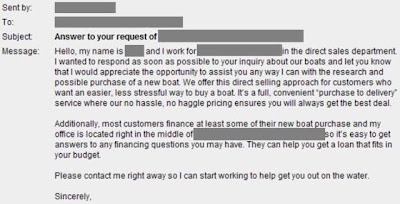
Businesses in industries around the globe have caught on to the fact that the Internet is no longer just a fad. By all accounts, more and more customers are turning to the Web as a resource to conduct research before visiting a dealership. Yet we're finding that as many as 60% of email leads sent to dealers get ignored. But as the story below illustrates, simply responding to an email lead doesn’t necessarily move the customer any closer to buying.
The following email lead was received at 3:00 PM on a Friday afternoon and included the customer’s email address, home, and cell phone numbers. (The names and product affiliations have been changed to protect the guilty)
* * * * * * * * * * * * * * * * * * * * * * * * *
Form: Request a Quote
Model: (YEAR, MAKE, MODEL)
Purchase Timeframe: Within 72 hours
Comments:
We are pre-approved for a boat loan from our bank. Please provide a quote that includes all dealer prep, trailer, tax, and licensing.
* * * * * * * * * * * * * * * * * * * * * * * * *
How would you respond to this email inquiry? Sounds like a hot opportunity right?
Here is a copy of the actual response sent after 5:00 PM on Saturday afternoon -- 26+ hours later.

Uh, hello, McFly… did you happen to read the customer’s original email?
Why would you ask the customer to call you when they gave you their home and cell phone numbers?
What do you think the customer is going to expect your service response to be if it took you 26+ hours to respond to a simple inquiry like this one?
To help you improve the effectiveness of your email responses, here is a basic outline for email responses.
1. Thank the individual for inquiring
2. Introduce yourself and the company
3. ANSWER THE CUSTOMER’S QUESTIONS!
4. ASK 1-2 OPEN-ENDED QUESTIONS TO ELICIT A RESPONSE
5. Set the stage for a follow-up phone call
6. Ask for their phone number if they didn’t provide one
7. Give the customer a way to contact you directly before your call
8. Thank the individual again for inquiring
Whether it’s responding to a request for: price quote, trade-in value, or simply a brochure, this format will help accelerate the customer through their buying process.
Want help designing and executing effective lead management strategies? Call 888.836.8567 or contact us by clicking here to develop comprehensive lead generation, lead capture, and lead nurturing strategies.





